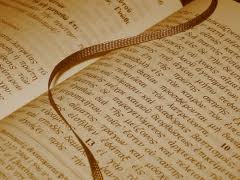"Once for All" -- Hebrews 9:11-28
 Tuesday, February 11, 2014 at 10:01AM
Tuesday, February 11, 2014 at 10:01AM  The Thirteenth in a Series of Sermons on the Book of Hebrews
The Thirteenth in a Series of Sermons on the Book of Hebrews
Christianity is not primarily a religion of morals and ethics. Christianity is a religion centering around shed blood, a Roman cross, and an empty tomb. The animal sacrifices and the purification rites of the old covenant served a number of very important purposes. For one thing, the very need for such sacrifices demonstrates that our sins are a great offense to a holy God, and that satisfaction must be made to his holy justice in order to turn aside his wrath. That the sacrifices were offered by a high priest who alone could enter the Most Holy Place after making sacrifices for his own sins, is a graphic illustration that our sin separates us from the presence of God. And while providing a provisional and temporary relief from sin, ultimately, the nature of these sacrifices shows that they were intended to teach God’s people and prepare the nation of Israel for the coming of Jesus Christ. But as the author of Hebrews continues to make his case for the superiority of the priesthood of Jesus Christ and the new and better covenant, he now describes how Jesus offers a sacrifice that is much superior in every way to the types and shadows of the old covenant, thereby rendering it obsolete, and establishing the new covenant in his blood.
As we continue our series on the Book of Hebrews, we are working our way though that section of the author’s extended argument for the superior priesthood of Jesus Christ, and the nature of the once for all sacrifice for sin made by our Lord, the great high priest. One of the remarkable things about the Book of Hebrews is that the author keeps building his case by adding additional arguments to those already made. In chapter 7, the author described how Jesus is an eternal priest after the order of Melchizadek, tying our Lord’s priestly office to this mysterious figure to whom Abraham paid tithes. Then in chapter 8, we saw that with the coming of Jesus Christ the new covenant era is now a reality, and the old covenant is no longer in force. Jeremiah’s well-known prophecy of a new and better covenant was the fulfillment of the covenant promise God made to Abraham, so that all those who are Christ’s are the children of Abraham.
Throughout both of these chapters, the author has shown that everything in the Siniatic covenant (the law, the tabernacle, and the priesthood) was designed to teach the people of God about the superior priesthood of Jesus Christ whose once for all sacrifice for sin puts an end to the Old Testament sacrificial system. Jesus is the better priest with the better sacrifice (himself), and his death alone, once and for all, turns aside God’s wrath toward all those for whom he dies.
In chapters 9-10 (that section in which we now find ourselves) the author makes four important theological points building upon those points he has already made. In verses 1-10 of chapter 9 (which we covered last time), the author described the earthly tabernacle, the worship which was conducted there, and the role these things played in redemptive history. The tabernacle, its priests, and its sacrifices are types and shadows which point ahead to the coming of Jesus Christ. In the balance of chapter nine (vv. 11-28, our text this morning), the author discusses the nature and meaning of the death of Jesus (in light of the old covenant types and shadows) and sets forth how our Lord’s shed blood does what the sacrificial system associated with the old covenant could never do, remove the guilt of our sin and secure for us an eternal redemption. The old covenant sacrifices temporarily and provisionally turned aside God’s anger, but these can do nothing to assuage the consciences of guilty sinners.
To read the rest of this sermon: Click Here


Reader Comments